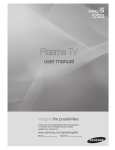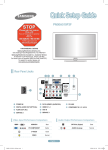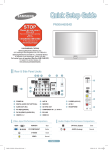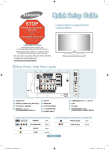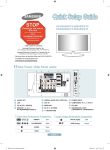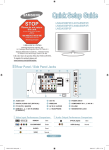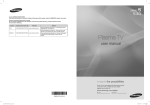Download Samsung PN58A550SF User manual
Transcript
PN50A550S1F/PN58A550S1F 1-800-SAMSUNG (7267864) Samsung Electronics America, Inc. 105 Challenger Road Ridgefield Park, NJ 07660-0511 Samsung Electronics Canada Inc., Customer Service 55 Standish Court Mississauga, Ontario L5R 4B2 Call center hours of operation (Mon-Sun 9AM-12AM EST). To register this product please visit www.samsung.com/global/register. Rear & Side Panel Jacks ($-)). 1 POWER IN 7 ANT IN # HEADPHONE 2 DIGITAL AUDIO OUT (OPTICAL) 8 COMPONENT IN 1, 2 / AV IN 1 3 AUDIO OUT (R/L) 9 EX-LINK 4 PC IN[PC]/[AUDIO] 0 HDMI IN 3 5 DVI IN (HDMI 2) (AUDIO-R/L) ! WISELINK 6 HDMI IN 1, 2 @ AV IN 2 Video Input Performance Comparison / / Audio Output Performance Comparison HDMI/DVI Best OPTICAL (Digital) Best PC/COMPONENT Better AUDIO (Analog) Normal S-VIDEO Good VIDEO Normal English - BN68-01363C-00Eng.indd 1 2008-02-13 오전 2:25:20 Remote Control Buttons See “Remote Control” in the owner’s instructions for details. 1 POWER Turns the TV on and off. 2 TV Selects the TV mode directly. 3 NUMERIC BUTTONS Press to change the channel. 4 Press to select additional channels (digital and analog) being broadcast by the same station. For example, to select channel “54-3”, press “54”, then press “ ” and “3”. 5 MUTE Press to temporarily cut off the sound. ^ ON/OFF Press to backlight the buttons on the remote. This function is convenient for using at night or when the room is dark. (Using the remote control with the light button set to On will reduce the battery usage time.) & PRE-CH Tunes to the previous channel. * CH Press to change channels. ( MENU Displays the main on-screen menu. 6 VOL Press to increase or decrease the volume. ) W.LINK(WISELINK) This function enables you to view and play photo and music files from an external device. 7 SOURCE Press to display and select the available video sources. a RETURN Returns to the previous menu. 8 CH LIST Used to display Channel Lists on the screen. 9 TOOLS Use to quickly select frequently used functions. 0 U P▲ / DOWN▼ / LEFT◄ / RIGHT► / ENTER Use to select on-screen menu items and change menu values. ! INFO Press to display information on the TV screen. @ COLOR BUTTONS Use these buttons in the Channel list and WISELINK. # CC Controls the caption decoder. $ E.MODE Press to select the preset display and sound modes for sports, cinema and games. b EXIT Press to exit the menu. c MTS Press to choose stereo, mono or Separate Audio Program (SAP broadcast). d DMA (Digital Media Adapter) Use this when connecting a Samsung DMA device through an HDMI interface and switching to DMA mode. For more information on the operating procedures, refer to the user manual of the DMA. ➢ This button is available when “Anynet(HDMI-CEC)” is “On”. (see page 87 of the owner's manual) e P.SIZE Picture size selection. f FAV.CH Press to switch to your favorite channels. % Use these buttons in the DMA, WISELINK and Anynet+ modes. ( : This remote can be used to control recording on Samsung recorders with the Anynet+ feature) ➢ The performance of the remote control may be affected by bright light. ➢ Using the remote control to set the light button to "On" will reduce the battery usage time. English - BN68-01363C-00Eng.indd 2 2008-02-13 오전 2:25:23 Connecting a DVD Player or Cable Box / Satellite receiver (Set-Top Box) Connecting to HDMI (High Definition Multimedia Interface) DVD Player or Cable Box / Satellite receiver (Set-Top Box) TV Rear Panel TV Side Panel 1 2 HDMI Cable (Not supplied) Connect an HDMI Cable between the HDMI IN (1, 2 or 3) jack on the TV and the HDMI jack on the DVD Player or Cable Box / Satellite receiver (Set-Top Box). Press the SOURCE button on the remote control until you see the Set-Top/Cable Box signal (see “Viewing an External Signal Source” on page ). or ➢ Please make sure the HDMI source’s (Set-Top/Cable Box) power is on before selecting HDMI from the Source List on the TV. What is HDMI? • HDMI, or high-definition multimedia interface, is an interface that enables the transmission of digital audio and video signals using a single cable. • The difference between HDMI and DVI is that the HDMI device is smaller in size and has the HDCP (High Bandwidth Digital Copy Protection) coding feature installed. ➢ Each DVD Player or Cable Box / Satellite receiver (Set-Top Box) has a different back panel configuration. ➢ The TV may not output sound and pictures may be displayed with abnormal color when DVD Player or Cable Box / Satellite receivers supporting HDMI versions older than 1.3 are connected. When connecting an older HDMI cable and there is no sound, connect the HDMI cable to the HDMI IN 2 jack and the audio cables to the DVI IN (HDMI2) [R-AUDIO-L] jacks on the back of the TV. If this happens, contact the company that provided the DVD Player or Cable Box / Satellite receiver to confirm the HDMI version, then request an upgrade. ➢ HDMI cables that are not 1.3 may cause annoying flicker or no screen display. Connecting to DVI (Digital Visual Interface) DVD Player or Cable Box / Satellite receiver (Set-Top Box) TV Rear Panel 1 2 Audio Cable (Not supplied) 3 2 ➢ HDMI/DVI Cable (Not supplied) Connect a HDMI/DVI Cable or DVIHDMI Adapter between the HDMI IN 2 jack on the TV and the DVI jack on the DVD Player or Cable Box/ Satellite receiver (Set-Top Box). Connect Audio Cables between the DVI IN (HDMI 2) [R-AUDIO-L] jack on the TV and the DVD Player or Cable Box / Satellite receiver (SetTop Box). Press the SOURCE button on the remote control until you see the Set-Top/Cable Box signal (see “Viewing an External Signal Source” on page ). Each DVD Player or Cable Box / Satellite receiver (Set-Top Box) has a different back panel configuration. ➢ When connecting a DVD Player or Cable Box / Satellite receiver (SetTop Box), match the color of the connection terminal to the cable. ➢ When using an HDMI / DVI cable connection, you must use the HDMI IN 2 jack. Continued... English - 3 BN68-01363C-00Eng.indd 3 2008-02-13 오전 2:25:28 Connecting to Y, PB, PR DVD Player or Cable Box/ Satellite receiver (Set-Top Box) 1 TV Rear Panel 2 2 3 Audio Cable (Not supplied) Component Cable (Not supplied) Connect a Component Cable between the COMPONENT IN (1 or 2) [Y, PB, PR] jacks on the TV and the COMPONENT [Y, PB, PR] jacks on the DVD Player or Cable Box / Satellite receiver(Set-Top Box). Connect Audio Cables between the COMPONENT IN (1 or 2) [RAUDIO-L] jacks on the TV and the AUDIO OUT jacks on the DVD Player or Cable Box / Satellite receiver (Set-Top Box). Press the SOURCE button on the remote control until you see the Set-Top/Cable Box signal (see “Viewing an External Signal Source” on page ). ➢ Component video separates the video into Y (Luminance (brightness)), PB (Blue) and PR (Red) for enhanced video quality. Be sure to match the component video and audio connections. For example, if connecting the video cable to COMPONENT IN, connect the audio cable to COMPONENT IN also. ➢ ➢ Each DVD Player or Cable Box / Satellite receiver (Set-Top Box) has a different back panel configuration. When connecting a DVD Player or Cable Box / Satellite receiver (Set-Top Box), match the color of the connection terminal to the cable. Connecting a Camcorder TV Side Panel Camcorder or 1 2 S-Video Cable(Not supplied) Video Cable (Not supplied) Audio Cable (Not supplied) 2 3 4 ➢ Each Camcorder has a different back panel configuration. ➢ When connecting a Camcorder, match the color of the connection terminal to the cable. Locate the A/V output jacks on the camcorder. Connect a Video Cable (or SVideo Cable) between the AV IN 2 [VIDEO] (or S-VIDEO) jack on the TV and the VIDEO OUT jack on the Camcorder. Connect Audio Cables between the AV IN 2 [L-AUDIO-R] jacks on the TV and the AUDIO OUT jacks on the Camcorder. Press the SOURCE button on the remote control until you see the Camcorder signal (see “Viewing an External Signal Source” on page ). English - 4 BN68-01363C-00Eng.indd 4 2008-02-13 오전 2:25:31 Connecting a VCR TV Rear Panel TV Side Panel 1 VCR Rear Panel 2 2 Audio Cable (Not supplied) 3 Video Cable (Not supplied) Antenna Cable (Not supplied) 4 ➢ ➢ ➢ ➢ Unplug the cable or antenna from the back of the TV. Connect the cable or antenna to the ANT IN terminal on the back of the VCR. Connect an Antenna Cable between the ANT OUT terminal on the VCR and the ANT IN terminal on the TV. Connect a Video Cable between the VIDEO OUT jack on the VCR and the AV IN 1 [Y/VIDEO] or AV IN 2 [VIDEO] jack on the TV. Connect Audio Cables between the AUDIO OUT jacks on the VCR and the AV IN 1 (or AV IN 2) [R-AUDIOL] jacks on the TV. Press the SOURCE button on the remote control until you see the VCR signal (see “Viewing an External Signal Source” on page 11). If you have a “mono” (non-stereo) VCR, use a Y-connector (not supplied) to hook up to the right and left audio input jacks of the TV. If your VCR is stereo, you must connect two cables. Each VCR has a different back panel configuration. When connecting a VCR, match the color of the connection terminal to the cable. When connecting to AV IN 1, the color of the AV IN 1 [Y/VIDEO] jack (Green) does not match the color of the video cable (Yellow). Connecting a S-Video TV Side Panel TV Rear Panel 1 VCR Rear Panel 2 3 2 4 S-Video Cable (Not supplied) To begin, follow steps 1 in the previous section to connect the antenna or cable to your VCR and your TV. Connect an S-Video Cable between the S-VIDEO OUT jack on the VCR and the AV IN 2 [S-VIDEO] jack on the TV. Connect Audio Cables between the AUDIO OUT jacks on the VCR and the AV IN 2 [R-AUDIO-L] jacks on the TV. Press the SOURCE button on the remote control until you see the VCR signal (see “Viewing an External Signal Source” on page ). ➢ An S-Video may be included with your VCR. (If not, check your local electronics store.) ➢ Each VCR has a different back panel configuration. ➢ When connecting a VCR, match the color of the connection terminal to the cable. Audio Cable (Not supplied) English - 5 BN68-01363C-00Eng.indd 5 2008-02-13 오전 2:25:38 Connecting a Digital Audio System TV Rear Panel 1 Digital Audio System Connect an Optical Cable between the DIGITAL AUDIO OUT (OPTICAL) jacks on the TV and the Digital Audio Input (OPTICAL) jacks on the Digital Audio System. When a Digital Audio System is connected to the “DIGITAL AUDIO OUT (OPTICAL)” jack: Decrease the volume of the TV, and adjust the volume level with the system’s volume control. ➢ OPTICAL: converts the electric signal into an optical light signal, and transmits it through glass fibers. Optical Cable (Not supplied) ➢ ➢ ➢ 5.1CH audio is possible when the TV is connected to an external device supporting 5.1CH. Each Digital Audio System has a different back panel configuration. When the receiver (home theater) is set to On, you can hear sound output from the TV’s Optical jack. When the TV is displaying a DTV(air) signal, the TV will send out 5.1 channel sound to the Home theater receiver. When the source is a digital component such as a DVD and is connected to the TV via HDMI, only 2 channel sound will be heard from the Home Theater receiver. If you want to hear 5.1 channel audio, connect the DIGITAL AUDIO OUT (OPTICAL) jack on the DVD player or Cable/Satellite Box directly to an Amplifier or Home Theater, not the TV. Connecting an Amplifier / DVD Home Theater TV Rear Panel 1 Amplifier / DVD Home Theater Audio Cable (Not supplied) Connect Audio Cables between the AUDIO OUT [R-AUDIO-L] jacks on the TV and AUDIO IN [L-AUDIO-R] jacks on the Amplifier/DVD Home Theater. When an audio amplifier is connected to the AUDIO OUT [R-AUDIO-L] jacks terminals : Decrease the volume of the TV, and adjust the volume level with the Amplifier’s volume control. ➢ Each Amplifier / DVD Home Theater has a different back panel configuration. ➢ When connecting an Amplifier / DVD Home Theater, match the color of the connection terminal to the cable. English - 6 BN68-01363C-00Eng.indd 6 2008-02-13 오전 2:25:43 Connecting a PC Using the D-Sub Cable Using the D-Sub Cable 1 2 TV Rear Panel PC Connect a D-Sub cable between the PC IN [PC] jack on the TV and the PC output jack on your computer. Connect a PC Audio cable between the PC IN [AUDIO] jack on the TV and the Audio Out jack of the sound card on your computer. ➢ When connecting a PC match the color of the connection terminal to the cable. PC Audio Cable (Not supplied) 2 D-Sub Cable (Not supplied) Using the HDMI/DVI Cable TV Rear Panel Using the HDMI/DVI Cable 1 PC 2 Connect a HDMI/DVI cable between the [HDMI IN 2] jack on the TV and the PC output jack on your computer. Connect a 3.5 mm Stereo plug to 2 RCA cable between the DVI IN (HDMI IN 2) [R-AUDIO-L] jacks on the TV and the Audio Out jack of the sound card on your computer. ➢ When connecting a PC match the 2 3.5 mm Stereo plug to 2 RCA Cable (Not supplied) color of the connection terminal to the cable. HDMI/DVI Cable (Not supplied) ➢ Each PC has a different back panel configuration. ➢ When using an HDMI/DVI cable connection, you must use the HDMI IN 2 terminal. English - 7 BN68-01363C-00Eng.indd 7 2008-02-13 오전 2:25:49 Turning the TV On and Off Press the POWER button on the remote control. The TV will be turned on and you will be able to use its features. You can also use the Power button on the front of the TV ➢ If your TV isn’t turned on when the Power button is pressed: Press the TV button to check if the TV mode has been chosen. Viewing the Menus and Displays Your TV has a simple, easy-to-use menu system that appears on the screen. This system makes it convenient and fast to use the TV’s features. The TV also displays the status of many features. Memorizing the Channels Selecting the Video Signal-source Before your television can begin memorizing the available channels, you must specify the type of signal source that is connected to the TV(i.e., an air or a cable system). 1 Press the MENU button to display the menu. Press the ▲ or ▼ button to select Channel, then press the ENTER button. 2 Press the ENTER button to select Antenna. Press the ▲ or ▼ button to select Air or Cable, then press the ENTER button. Press the EXIT button to exit. Viewing the Menus With the power on, press the MENU button. The main menu appears on the screen. The menu’s left side has icons: Picture, Sound, Channel, Setup, Input, Application. 2 Press the ▲ or ▼ button to select one of the icons. Then press the ENTER button to access the icon’s sub-menu.from the menu. Press the EXIT button to exit. Channel 1 Antenna : Air Air Cable Auto Program Channel List Clear Scrambled Channel Fine Tune Signal Strength ➢ It takes about one minute until the on-screen menu disappears. Picture Mode : Standard Cell Light :7 Contrast : 90 Brightness : 45 Sharpness : 50 Color : 50 Tint (G/R) : G50/R50 Storing Channels in Memory (Automatic Method) 1 2 Press the MENU button to display the menu. Press the ▲ or ▼ button to select Channel, then press the ENTER button. Press the ▲ or ▼ button to select Auto Program, then press the ENTER button. Detailed Settings Channel Antenna : Air Auto Program ► Channel List Clear Scrambled Channel Fine Tune Signal Strength Displaying Status Information Press the INFO button on the remote control. The TV will display the channel, the type of sound, and the status of certain picture and sound settings. ➢ The information window automatically disappears after a few seconds. Press the INFO button once to manually close the window. Press the button to select an antenna connection, then press the ENTER button. ➢ Air: Air antenna signal. Cable: Cable antenna signal. Auto: Air and Cable antenna signals. Auto Program TV #1 DTV Air 3 Sun, Sep 3 1:45 pm Dolby Digital 13-1 M. Spillane’s Mike Hammer 480i 4:3 English Select the antennas to memorize. 12:59 pm - 1:59 pm Bonocrunch Start Air Cable Start Auto Start Move Enter Return Continued... English - BN68-01363C-00Eng.indd 8 2008-02-13 오전 2:25:50 Picture Control 4 When selecting the Cable TV system: Press the ENTER button to start the auto program. Press the ▲, ▼, ◄, ► to select the correct analog signal cable system source among STD, HRC, and IRC, then press the ENTER button. If you have Digital cable TV, select the cable system signal source for both Analog and Digital. ➢ STD, HRC, and IRC identify various types of cable TV systems. Contact your local cable company to identify the type of cable system that exists in your particular area. At this point the signal source has been selected. You can select the type of picture which best corresponds to your viewing requirements. Changing the Picture Standard 1 Picture Auto Program Select the cable system. Analog STD HRC IRC Digital STD HRC IRC Move Press the MENU button to display the menu. Press the ENTER button to select Picture. Press the ENTER button to select Mode. Press the ▲ or ▼ button to select Dynamic, Standard, or Movie, then press the ENTER button. Enter Return Mode : Dynamic Cell Light Contrast : 7Standard Movie : 80 Brightness : 45 Sharpness : 50 Color : 50 Tint (G/R) : G50/R50 Detailed Settings 5 The TV begins memorizing all available stations. If you want to stop Auto Programming, press the ENTER button. The Stop Auto Program? message will be displayed. Select Yes by pressing the ◄ or ► button, then press the ENTER button. Picture Mode • Dynamic: Select the picture for high-definition in a bright room. • Standard: Select the picture for the optimum display in the normal environment. • Movie: Select the picture for viewing movies in a dark room. Auto Program Stop Auto Program? Air 10 3% Customizing the Picture Settings No Yes Move Enter Return ● The TV must be connected to an antenna/cable in order to receive digital TV signals. Even if a particular channel is deleted from the memory, you can always tune to that channel directly by using the number buttons on the remote control. 1 2 To select the desired picture mode, follow the “Changing the Picture Standard” instructions number 1. Press the ▲ or ▼ button to select Cell Light, Contrast, Brightness, Sharpness, Color, or Tint (G/R), then press the ENTER button. Viewing All Channels Mode :Standard Picture 1 Press the MENU button to display the menu. Press the ▲ or ▼ button to select Channel, then press the ENTER button. Brightness : 45 2 Press the ▲ or ▼ button to select Channel List, then press the ENTER button. Press the ◄ button to select Added Channels. Sharpness : 50 Color : 50 Tint (G/R) : G50/R50 Press the ▲ or ▼ button to select All Channels, then press the ENTER button. Shows all currently available channels. Press the ▲ or ▼ button to select a channel to view, then press the ENTER button. Detailed Settings 3 All Channels Air 6-1 7 ♥ SBS Air 7-1 ♥ KBS D-2 9 9-1 10 10-1 11-1 19 22 Air ♥ KBS D-1 Air ♥ EBS DTV ♥ MBC DTV Air Air ■ Antenna ■ Zoom ■ Select TOOLS Cell Light : 7 Contrast : 95 ► Picture Options Option ► Next Program Continued... English - BN68-01363C-00Eng.indd 9 2008-02-13 오전 2:25:51 To Select the Source 3 Press the ◄ or ► button to decrease or increase the value of a particular item. Press the ENTER button. Press the EXIT button to exit. 7 Move Adjust Enter Press the MENU button. Press the ▲ or ▼ button to select Input, then press the ENTER button. Input Cell Light 1 Return Source List Edit Name ➢ • When you make changes to Cell Light, Contrast, Brightness, Sharpness, Color, or Tint (G/R) the OSD will be adjusted accordingly. • When in PC mode, Tint(G/R), Sharpness and Color are not available. •Each adjusted setting will be stored separately according to its input mode. • Cell Light: Selects the brightness of PDP Cell Light. • Contrast: Adjusts the contrast level of the picture. • Brightness: Adjusts the brightness level of the picture. • Sharpness: Adjusts the edge definition of the picture. • Color: Adjusts color saturation of the picture. • Tint(G/R): Adjusts the color tint of the picture by compensating the red and green color 2 Press the ENTER button again to select Source List. Press the ▲ or ▼ button to select a signal source, then press the ENTER button. TV AV1 ---- AV2 ---- S-Video ---- Component1 ---- Component2 ---- PC Refresh ---TOOLS Option ➢ Available signal sources: TV, AV1, AV2, S-Video, Component1, Component2, PC, HDMI1, HDMI2/DVI, HDMI3, USB. ➢ You can choose only those external devices that are connected to the TV. In the Source List, connected inputs will be highlighted and sorted to the top. Inputs that are not connected will be sorted to the bottom. ➢ Using the Color buttons on the remote with the Source list. • Red (Refresh): Refreshes the connecting external devices. • TOOLS (Option): Displays the Edit Name and Information menus. English - 10 BN68-01363C-00Eng.indd 10 2008-02-13 오전 2:25:51 Troubleshooting If the TV seems to have a problem, first try this list of possible problems and solutions. If none of these troubleshooting tips apply, call your nearest Samsung service center. Problem Poor picture quality. Possible Solution No sound or sound is too low at maximum volume. - Try another channel. - Adjust the antenna. - Check all wire connections. - Try another channel. - Adjust the antenna. - Try another channel. - Press the SOURCE button. - Make sure the TV is plugged in. - Check the antenna connections. - Make sure the MUTE button is off. First, check the volume of units connected to your TV (digital broadcasting receiver, DVD, cable broadcasting receiver, VCR, etc.). Then, adjust the TV volume accordingly. Picture rolls vertically. Check all connections. The TV operates erratically. Unplug the TV for 30 seconds, then try operating it again. The TV won’t turn on. Make sure the wall outlet is working. Remote control malfunctions - Replace the remote control batteries. - Clean the upper edge of the remote control(transmission window). - Check the battery terminals. - Make sure the remote has batteries. - Check that the “+” and “-” ends of the batteries are inserted correctly. Please check the digital signal strength and input antenna. Poor sound quality. No picture or sound. Digital broadcasting screen problem. The image is too light or too dark. The image is too large or too small. The visual qualities of digital channels vary. Screen is black and power indicator light blinks steadily. Although the TV caption shows HD, the visual quality is not satisfactory. - Adjust the Brightness and Contrast. - Adjust the Fine tuning. Adjust the Size settings. The visual qualities of digital channels may vary depending on the original production method(analog or digital). - If the original production method is digital: High visual quality. - If the original production method is analog: The digital program displayed on the screen is originally an analog program which has been converted to digital. The visual quality is of an SD(Standard Definition) grade. On your computer check; Power and Signal Cable. The TV is using its power management system. Move the computer’s mouse or press any key on the keyboard. On your equipment check (STB, DVD, etc) ; Power and Signal Cable. The TV is using its power management system. Press the Source button on the panel or remote control. Turn the TV off and on. The HD(High Definition) caption that appears when switching channels or when pressing the Information button on the remote control means the selected channel is a digital channel. If the broadcasting station converts an analog signal into digital and transmits the signal, the visual quality may not be perfect. A distorted picture appears in the corner of the screen. If Just Scan is selected in some external devices, a distorted picture may appear in the corner of the screen. This symptom is caused by external devices, not the TV. A strange sound is heard. This is caused by minor systems operation and is not a defect. Pixels are visible on the screen. There may be few bright or dark pixels on the screen. These pixels will have no impact on the performance of the product. The "Resets all settings to the default values" message appears. This appears when you press and hold the EXIT button for a while. The product settings are reset to the factory defaults. English - 11 BN68-01363C-00Eng.indd 11 2008-02-13 오전 2:25:52 Contact SAMSUNG WORLD-WIDE If you have any questions or comments relating to Samsung products, please contact the SAMSUNG customer care center. Country Customer Care Center Web Site Address Samsung Electronics Canada Inc., Customer Service 55 Standish Court Mississauga, Ontario L5R 4B2 Canada CANADA 1-800-SAMSUNG (7267864) www.samsung.com/ca U.S.A 1-800-SAMSUNG (7267864) www.samsung.com Samsung Electronique Canada Inc., Service à la Clientèle 55 Standish Court Mississauga, Ontario L5R 4B2 Canada Samsung Electronics America, Inc. 105 Challenger Road Ridgefield Park, NJ 07660-0511 BN68-01363C-00 BN68-01363C-00Eng.indd 12 2008-02-13 오전 2:25:52













